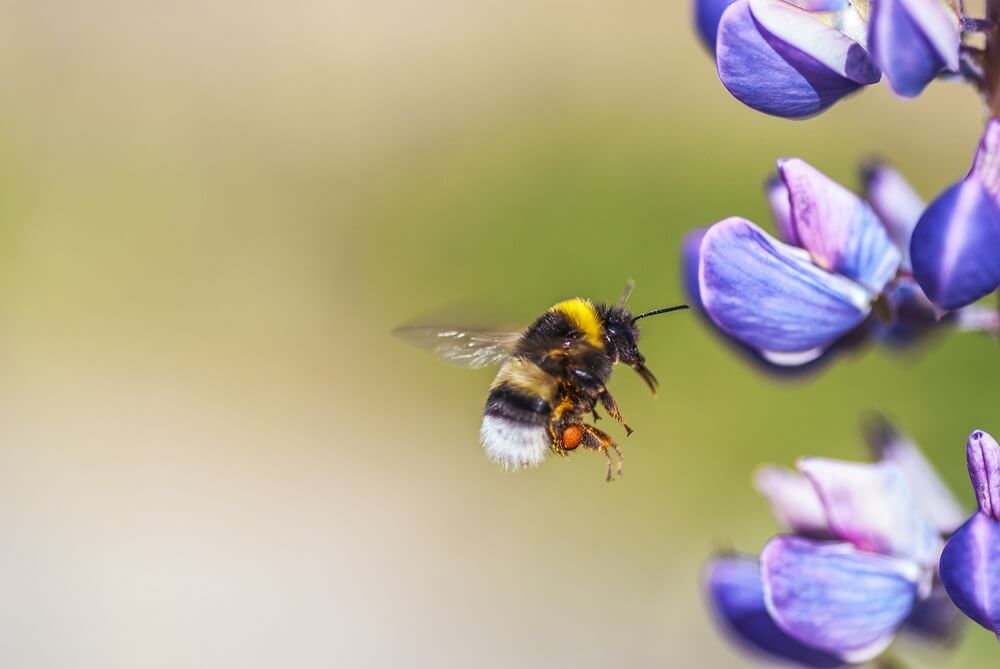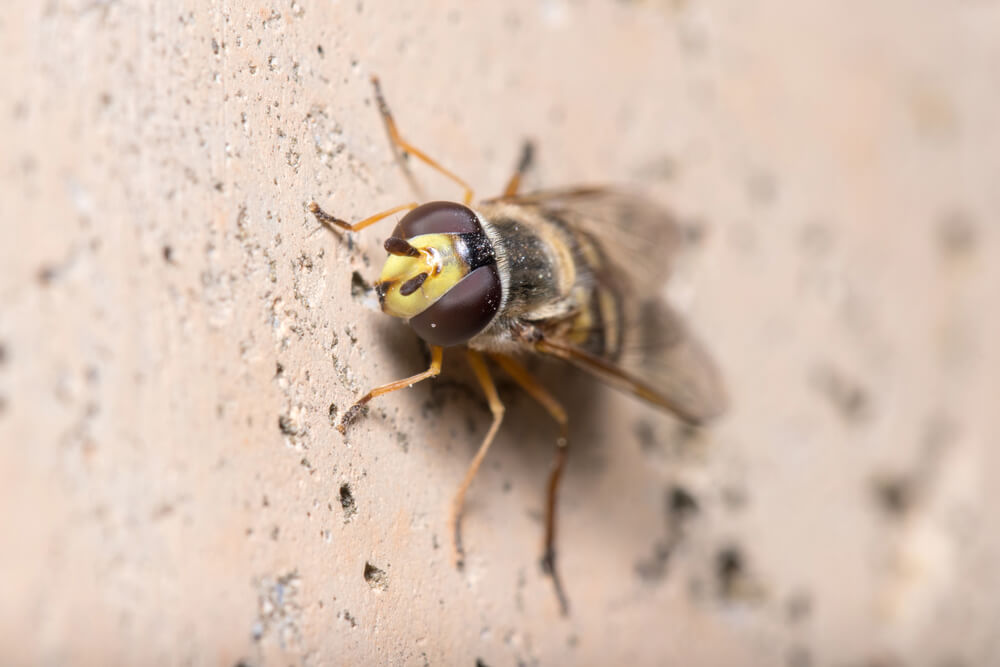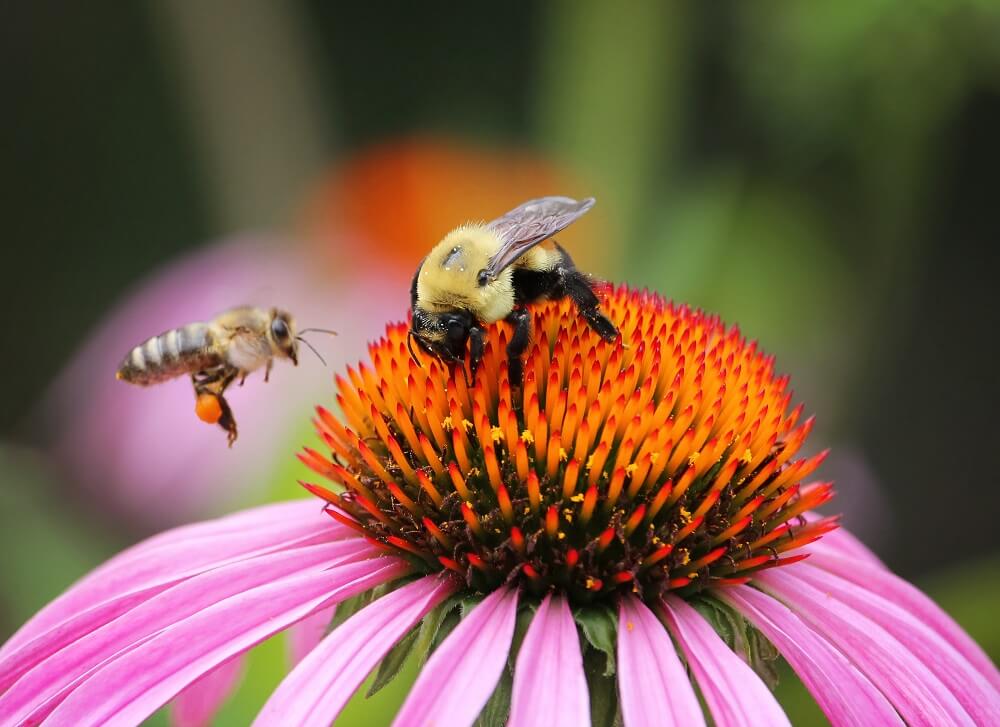In this article:
How Long Do Bumble Bees Live?
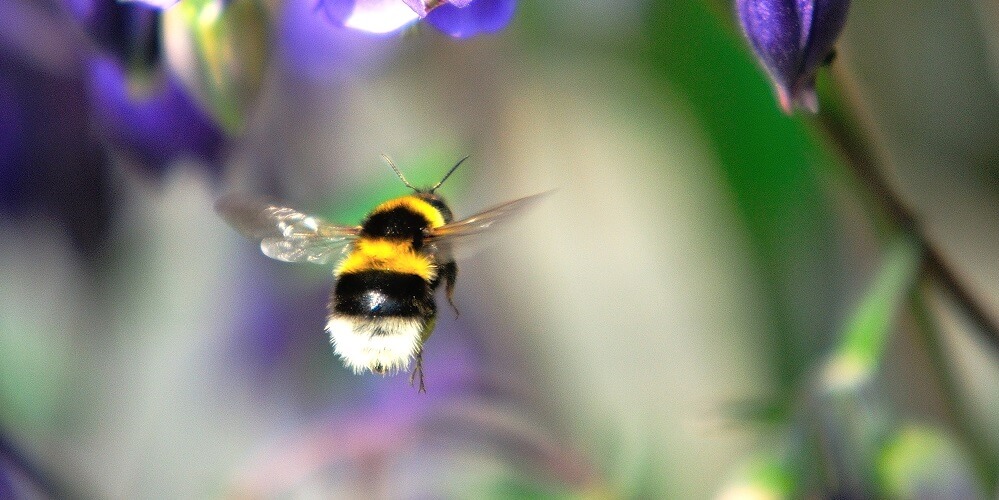
Bumblebee Lifespan:
- Queen bumblebee: 1 year
- Worker bumblebee: 28 days
- Drone bumblebee: 14 days
It all boils down to this:
The lifespan of a bumblebee is determined by its job duties. And each bumblebee serves a very important role in its colony.
So let’s begin with the royal highness:
The queen bumblebee.
Related: Do Bumble Bees Make Honey?
How Long Do Queen Bumblebees Live?
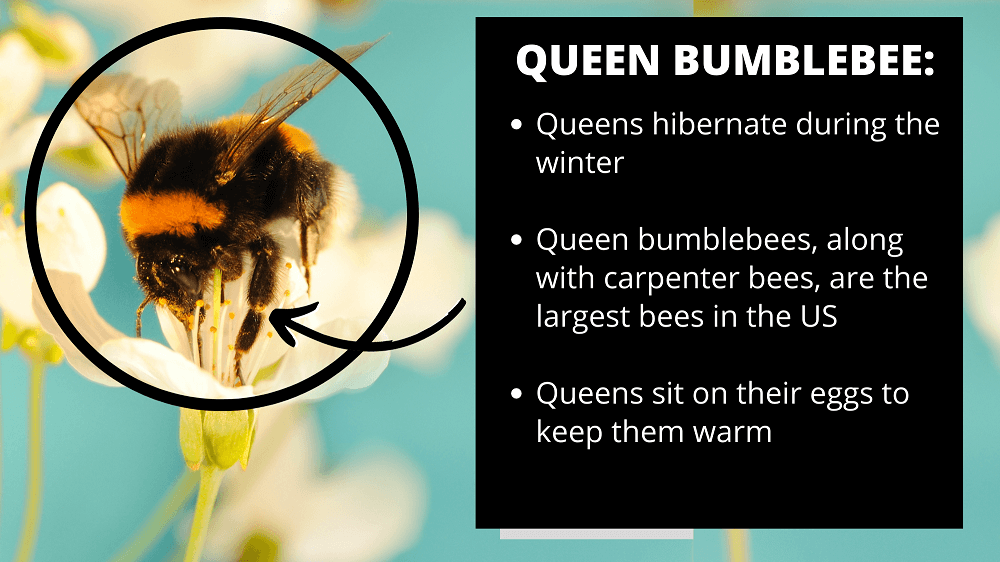
A queen bumblebee lives for about one year, making her the colony’s longest surviving bee.
New queen bumblebees hatch in the late summer. Then they leave the nest to mate, fill up on food, and look for a safe spot to hibernate throughout the winter.
And here’s the fascinating part:
Only queen bumblebees survive the winter. She hibernates while the rest of the colony dies off.
Then once spring arrives?
She starts laying eggs and building her own colony. Eventually, she passes away in the summer while new queens are born.
Then the cycle repeats itself, with new queens hibernating and then building their nests in the spring.
Related: Honeybees vs. Bumblebees: How Do They Compare?
How Long Do Worker Bumblebees Live?
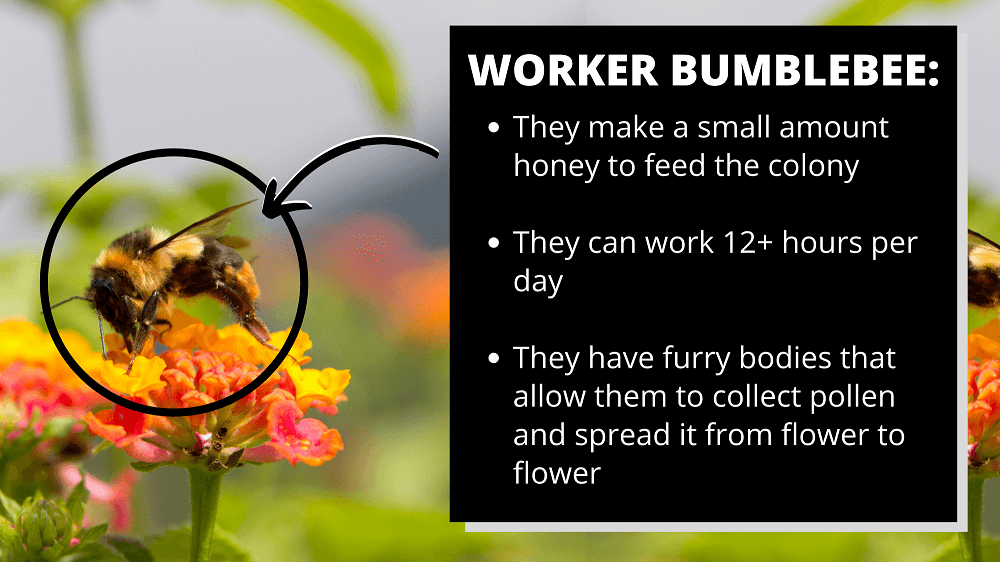
A worker bumblebee’s lifespan depends on her duties in the hive.
Here’s what it comes down to:
The more strenuous a bee’s job responsibilities, the shorter its lifespan is.
For example, bumblebees working outside the hive gathering nectar and pollen wear out more quickly.
Why?
Because they put much more stress on their wings and bodies by flying around and dealing with the outside elements.
Makes sense, right?
With that in mind, there are two main types of worker bumblebees:
- The forager bumblebees – Responsible for collecting nectar and pollen for food
- The house bumblebees – Takes care of the nest, queen, and baby bees.
Since the forager bumblebee works long days outside the hive, she only lives for about three weeks. On the other hand, the house bumblebees work inside the hive and can live up to 12 weeks.
But reminder:
Worker bumblebees never survive the winter. Queen bumblebees are the only bees in the colony to make it through winter because they hibernate.
Once spring comes, the queen bumblebee emerges from hibernation and starts laying eggs to form a new colony.
How Long Do Drone Bumblebees Live?
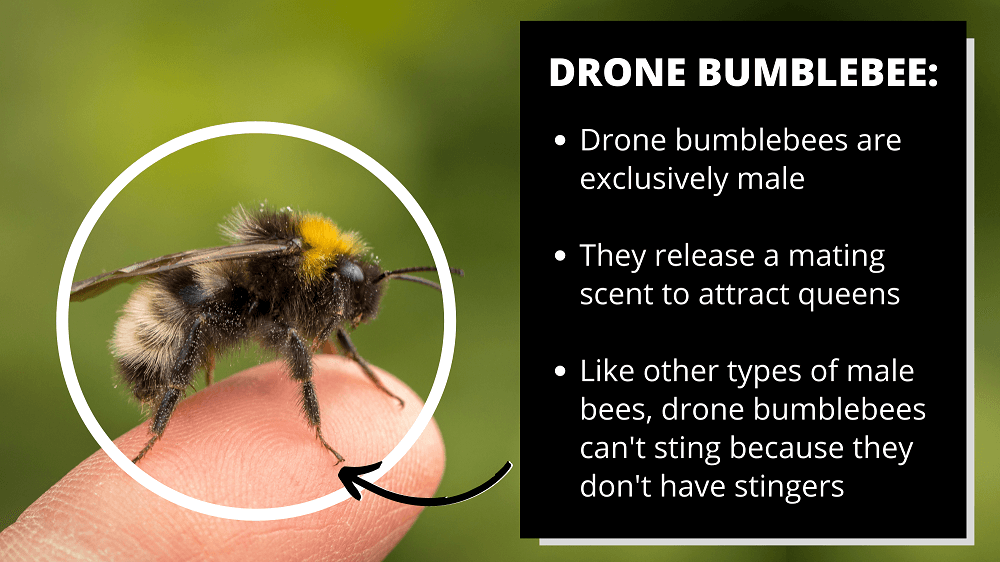
Male bumblebees are called drone bees, and they’re the shortest-lived bees in the hive.
Drone bumblebees live for about 14 days.
Here’s something that might surprise you:
Male bees (drones) don’t have stingers, so they can’t defend the hive. Their sole purpose is to mate with queen bees.
More importantly?
Drone bumblebees depart the colony and fly long distances – sometimes for many miles – to mate with a new queen from another hive. Many drones don’t end up mating because the competition is fierce. Only the fastest male bees get to mate.
Unlike drone honeybees, drone bumblebees don’t die after mating. They can mate as much as they want.
Now you might be asking…
What is the Lifecycle of a Bumblebee Egg?
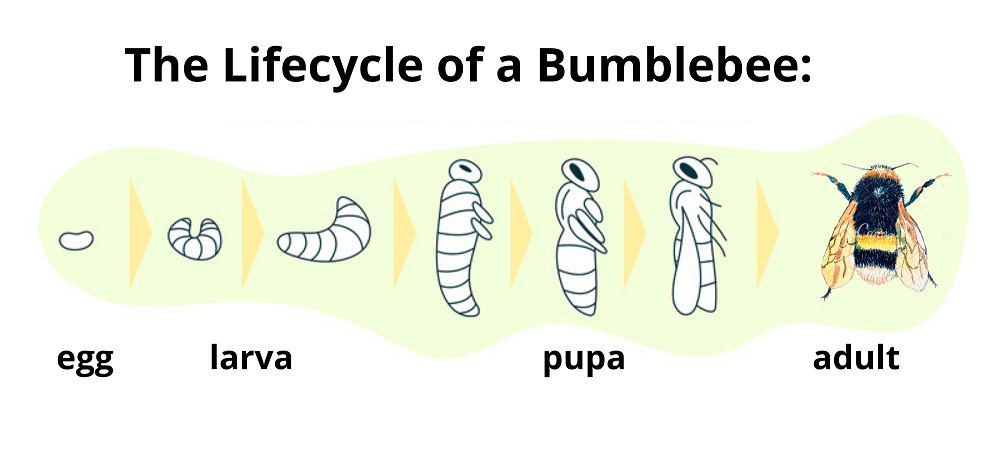
It takes five weeks for bumblebee eggs to hatch as adult bees. There are minor differences in the way baby bumblebees are reared depending on the bumblebee species, but here’s a familiar pattern:
Step 1: The Queen Bumblebee Lays the Egg
Like birds, queen bumblebees sit on their eggs to keep them warm. She keeps them at about 86°F (30°C).
The eggs hatch into larvae after around four days.
Step 2: The Eggs Hatch into Larvae
Larvae are tiny and look like little grubs or maggots.
The larvae continue to eat and develop, passing through several phases in their development. This development phase includes the larvae shedding their skin three times.
After about 14 days in the larvae stage, the larvae wrap themselves in a cocoon within the cell, similar to a butterfly.
Step 3: The Pupa Phase Arrives
In the pupa stage, the tiny insect concealed inside the cocoon resembles a mature bee. The bumblebee’s eyes, legs, and wings develop, and, finally, the little hairs that cover its body grow.
After about 14 days in the pupa stage, the now adult bumblebee is formed.
Step 4: The Adult Bee Hatches
Once fully formed, the adult bees chew their way out of their cocoons and start their new lives.
How Long Do Bumble Bees Live Without Food?
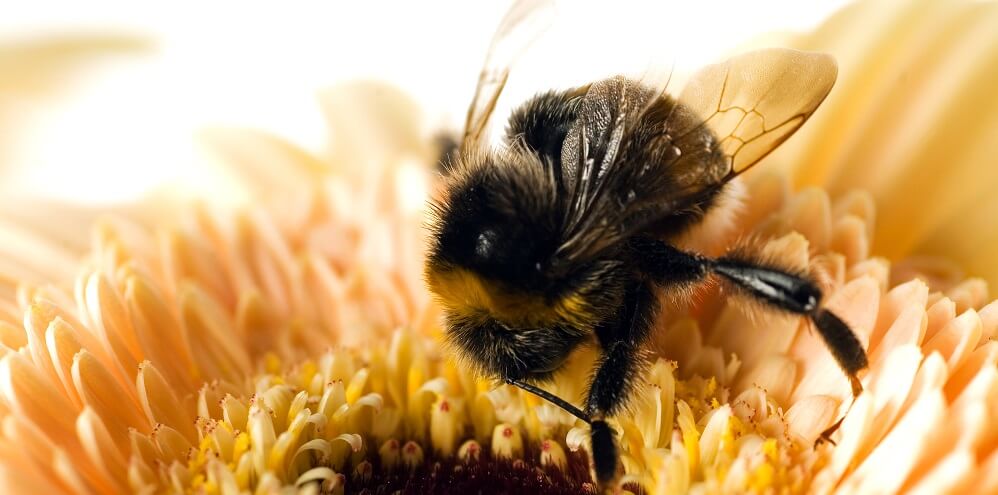
A bumblebee trapped inside a home or car will live less than 24 hours. To survive, bees need access to pollen and nectar from flowers.
But here’s the thing:
There is one exception to this. And that exception is when queen bumblebees hibernate.
You see, queen bumblebees don’t eat or work when they’re hibernating through the winter. Their metabolism slows down, and they burn very little energy. This allows them to survive the cold winter months.
Once temperatures reach near 40°F (5°C), the queen bumblebees emerge from their nest and start foraging for food to replenish their energy.
Related: How Many Eyes Does a Bee Have?
How Long Do Bumble Bees Live After Stinging?
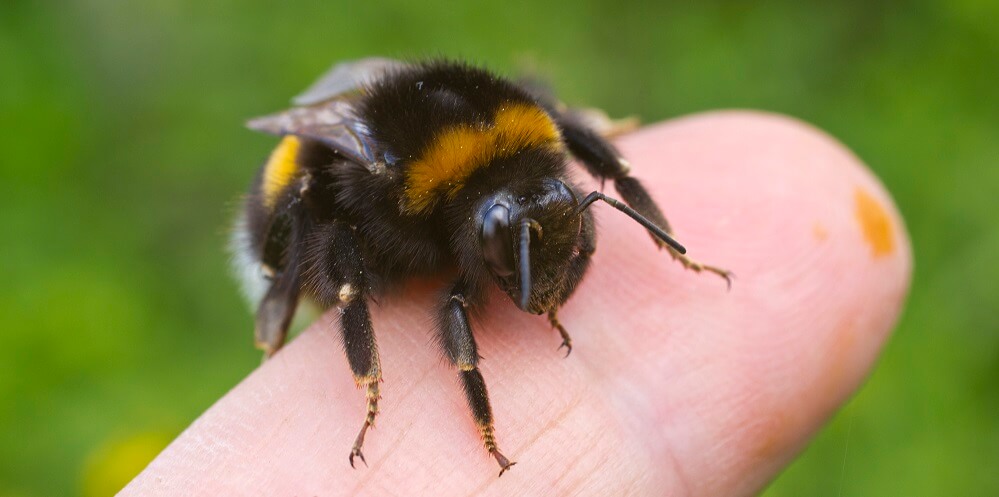
Fun fact:
Honeybees are the only bees that die after stinging.
As for bumblebees?
They live to see another day. This is because bumblebees have smooth stingers that don’t get hooked into the skin. So they can sting multiple times without trouble.
But honeybees, on the other hand?
They die after stinging because their stingers are barbed. When they sting something, their stinger gets stuck in the skin, and they can’t pull it out. A honeybee’s stinger is attached to its vital organs, so once the stinger gets pulled out, the honeybee’s “guts” also get ripped out with it.
And here’s another fact:
Only female bees have stingers. Male bees don’t have stingers because stingers are modified egg-laying devices. And since male bees don’t lay eggs, they have no purpose for stingers.
FAQs on “How Long Do Bumble Bees Live?”
- Where do bumble bees live?
- How long do large bumble bees live?
- How long does it take for a bumble bee to die?
- How do you know when a bumble bee is dying?
- Are bumble bees dying off?
- How long do bumble bees live after they sting?
- How long do bumble bees live in a hive?
- What can decrease the lifespan of a bumble bee?
Where do bumble bees live?
There are more than 250 bumblebee species all over the world. And 49 of those species live in the United States.
Like honey bees, bumblebees are social bees that live in hives that provide shelter and a place to raise their young. Bumblebees usually build their nests underground in empty rodent burrows or other holes abandoned by animals.
Other common nesting areas are gaps under houses, vegetation piles, tall grass, tree hollows, or birds nests.
If you spot a bumblebee nest, it’s best to leave it alone so the bees can live in peace. Bumblebees are generally gentle creatures, but they may buzz around you out of curiosity.
—> Go back to the FAQs on “How long do bumble bees live?”
More to Explore:
How long do large bumblebees live?
We get asked this question a lot, along with other questions like:
How long do big bumble bees live? How long do black bumble bees live?
Remember:
There are more than 250 bumblebee species, so the answer to the question, “What is the lifespan of a bumblebee?” varies. But here’s a general rule of thumb on the lifespans of bumblebees:
- Queen bumblebee: 1 year
- Worker bumblebee: 28 days
- Drone bumblebee: 14 days
—> Go back to the FAQs on “How long do bumble bees live?”
More to Explore:
How long does it take for a bumble bee to die?
Good question. Most bumblebees work themselves to death because they’re dedicated little insects. Worker bumblebees, for example, live about 28 days on average.
Most worker bumblebees die while they’re out foraging for food. They’ll literally rollover on a flower and pass away. This is because bumblebees work 12+ hour days, and it takes a toll on their legs, wings, and bodies.
—> Go back to the FAQs on “How long do bumble bees live?”
More to Explore:
How do you know when a bumble bee is dying? How does a bumblebee die?
Sometimes it’s hard to tell.
But in many cases, bees will cling to flowers and appear tired when they’re on the verge of death. They’ll often fall off the flowers when they’re dead, and you may find several dead bumblebees or other bees in your gardens near bee-friendly blooms. You may also see dead bees near their nest entrances.
Here’s the thing:
Bees die every day, but we don’t usually notice because they’re so small.
For example, a honey bee colony may lose over a thousand individuals each day, particularly in late spring and early summer.
Those bees most often die due to exhaustion. They wore down their thin wings over time, eventually rendering them unable to transport them. It’s a shame, but it’s true.
If you kneel in the dirt, you’re more likely to see dead bees. You’ll notice many more things by kneeling that you miss while you’re standing up.
Either way, bumblebees, and carpenter bees are the easiest bees to spot because they’re so large.
—> Go back to the FAQs on “How long do bumble bees live?”
More to Explore:
- How to Get Rid of Carpenter Bees Naturally
- Do Carpenter Bees Pollinate?
- Ground Bees: Are They a Threat to Your Yard?
Are bumble bees dying off?
Yes. In the US, bumblebees are experiencing a decline due to intense competition from honeybees.
European honeybees aren’t native to the United States like bumblebees, carpenter bees, and mason bees are.
Honeybees were first introduced to North America in the 17th century, and they have since become a big source of food for humans and livestock. Beeswax was a significant export, while honey was used to make everything from sweetener to medicine to cement.
The issue, says Manu Saunders, an entomologist, and professor at the University of New England in Australia, is that the presence of honeybees “could be hurting wild insects in multiple spots. Increasing numbers of honeybees might be depleting resources that wild insects require, and spreading parasites and diseases to wild insects.”
Stephen Buchmann, a pollination ecologist who focuses on bees, also had this to say about it:
“[Honeybee] colonies pull a huge amount of floral resources, like nectar and pollen, out of the wildlands. This takes food from native bees and other pollinators.”
So yes, bumblebees in the US are declining due to fierce food competition from honeybees.
According to the NY Department of Environmental Conservation, the number of American bumblebees in New York state has declined by 99% over the past 20 years.
Yet the US Department of Agriculture has taken far too long to recognize bumblebees as an endangered species. (They finally did in 2020, to the Bombus franklini genus of bumblebee, native to northern California and southern Oregon).
—> Go back to the FAQs on “How long do bumble bees live?”
More to Explore:
How long do bumble bees live after they sting?
Most people are shocked to learn that bumblebees don’t die after stinging.
Only honeybees die after stinging because their stinger is barbed, which means it gets pulled out and lodged into your skin. This kills the honeybee because their stingers are attached to critical internal organs.
Bumblebee stingers are smooth and don’t get hooked into human skin as honeybee stingers do, so bumblebees live to see another day after stinging.
—> Go back to the FAQs on “How long do bumble bees live?”
More to Explore:
How long do bumble bees live in a hive?
Bumblebee colonies live in their nests for one year before dying off.
The old queen, her female workers, and male drones will all die at the end of summer. Then, the newly hatched queens will survive to hibernate through the winter.
The new queen will have a nest that can house between 50-500 bumblebees in the spring.
Bumblebees require a cavity in which to construct their nest. The queens are opportunists, seeking out any available hole suitable for nesting.
Sometimes queen bumblebees nest above ground in hollow trees, bird nests, or rock walls. But mostly, bumblebee queens choose to nest underground. Abandoned mouse holes are a favorite spot for bumblebees since these spaces are private and safer.
—> Go back to the FAQs on “How long do bumble bees live?”
More to Explore:
- How to Keep Bees Away From Hummingbird Feeders
- Do Sweat Bees Sting or Bite?
- Wasps vs. Honeybees: Are They Different?
What can decrease the lifespan of a bumblebee? What is the life cycle of a bumble bee?
Several things can reduce the lifespan of a bumblebee.
Factors Affecting the Queen Bumblebee
The bumblebee queen is at risk of various dangers during her life. The first stage in which she’s vulnerable is during hibernation.
For example, while the queens go into hibernation, they become vulnerable to various parasites, according to studies on Turkish bumblebee queens.(1)
These parasites include mites and fungus, which can impact her ability to lay eggs.
A queen bumblebees’ lifespan can also shorten if her workers kill her. This is common among honeybees, who kill and replace their queen when her production of eggs slows down. But, it’s less common for bumblebees.
Related: What Do Bees Eat?
What Affects Worker Bumblebees
The lifespan of worker bumblebees depends on whether their job is foraging for food or tending to the nest.
Workers that spend their time within the nest tend to live longer. This is partly because they’re sheltered from dangers such as predators and natural elements. They eat pollen and nectar in the nest while making the honey they feed to the queen and baby bees.
Also, there’s a “competitive phase” that leads to the death of many worker bumblebees.(2, 3)
The competition phase happens when workers start to lay their own eggs. This encourages the queen and workers to act aggressively towards each other. The female workers can only produce male eggs, which causes the colony to fall. A healthy colony needs both male and female eggs.
The nest turns into a nightmare, where female workers begin attacking each other.
Other threats, such as predators and weather changes, confront foraging bumblebee workers.
Related: How Long Do Bees Live?
What Affects Drone Bumblebees
Like the worker bees, the male bumblebees go out to pollinate flowers. They also search for queens to mate with. This puts them at risk of predators while they’re flying around.
The bumblebee is preyed upon by birds, spiders, wasps, and flies while out foraging. Large predators like the badger may dig up and consume an entire colony in a few minutes.
